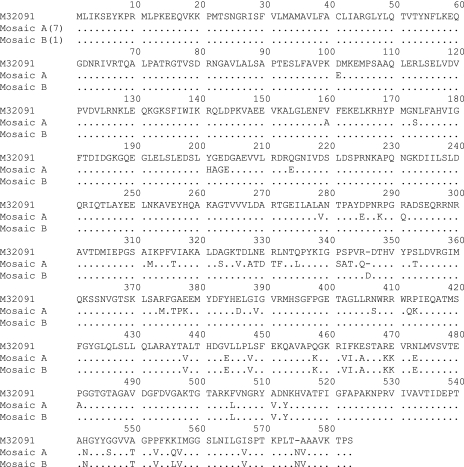With treatment options for gonorrhea diminishing, the isolation of Neisseria gonorrhoeae strains with reduced susceptibilities to the newer cephalosporins represents a worrying trend that requires monitoring and investigation. Mutations in the penA gene encoding the penicillin-binding protein 2 (PBP2) are a major contributor to the emergence of chromosomally mediated resistance to β-lactam antibiotics in N. gonorrhoeae. Recent studies have identified mosaic-like structures of the PBP2 in clinical isolates of N. gonorrhoeae with decreased susceptibilities to both cefixime and ceftriaxone (1, 2, 4, 5). These mosaic sequences are thought to have evolved from recombination events involving penA gene sequences from several Neisseria species, including N. perflava, N. sicca, and N. cinerea (1, 3). Thus, the reduced susceptibility to the newer cephalosporins is attributed to the acquisition of genetic material from resistant commensal Neisseria spp. by originally susceptible gonococci.
We have identified eight clinical isolates of N. gonorrhoeae harboring mosaic PBP2 sequences as part of an ongoing study investigating reduced susceptibility to ceftriaxone in Australian gonococcal isolates (6). DNA sequencing of the complete penA genes from these isolates revealed that seven of these strains possessed PBP2 amino acid sequences (Fig. 1, mosaic A) that were identical to the mosaic PBP2 sequence previously described by Ito et al. (2). All seven strains had reduced susceptibility to ceftriaxone (MIC = 0.06 mg/liter). The remaining strain possessed a variation of the mosaic sequence (Fig. 1, mosaic B). Briefly, the first 430 amino acids of the mosaic B sequence in this strain were nearly identical to the GenBank reference sequence M32091, except for an additional Asp-345A codon, whereas the remaining amino acids were similar to those in the mosaic sequence described by Ito et al. but with three substitutions. Notably, the strain possessing this variant mosaic B sequence was fully susceptible to ceftriaxone (MIC ≤0.008 mg/liter).
FIG. 1.
Mosaic PBP2 amino acid sequences identified in the N. gonorrhoeae isolates in this study. The sequences are aligned with a GenBank N. gonorrhoeae sequence (accession number M32091). The number of isolates with each pattern is indicated in parentheses.
Takahata et al. recently demonstrated that particular amino acid substitutions in the mosaic PBP2 (G545S, I312M, V316T) were responsible for reduced susceptibility to cefixime in Japanese gonococci (4). All three substitutions were present in our seven strains with the mosaic A sequence but were absent in the variant mosaic B sequence, suggesting that they may also have a role in altered ceftriaxone susceptibility. However, Takahata et al. also found that these substitutions and several others, although impinging on cefixime MICs, did not greatly affect ceftriaxone susceptibility (4). This was also shown in transformation experiments conducted by Takahata et al. in which full-length mosaic penA sequences conferred only very minor reductions in ceftriaxone susceptibility to a susceptible strain and so could not fully explain the reduced susceptibility of the donor strain (4).
The demonstration that full susceptibility to ceftriaxone is possible in the presence of this variant mosaic B sequence has been, thus far, detected only in a single isolate. However, this finding adds weight to those of Takahata et al. (4) by suggesting that other mosaic-associated mutations located within the transpeptidase domain have but little impact on ceftriaxone susceptibility. This brings into question the extent of the contribution of mosaic sequences in conferring reduced susceptibility to ceftriaxone in N. gonorrhoeae. These findings would need to be confirmed by additional evidence such as the detection of additional ceftriaxone-susceptible gonococci with mosaic B or similar sequences and adjunctive evidence derived from transformation experiments. Other mechanisms that may confer reduced susceptibility to ceftriaxone, including mutations in the ponA (PBP1) gene (5), have been proposed, and alternatively, as yet undetected second-site mutations may also be responsible for reversion to the susceptibility patterns reported here. Overall, the data currently available suggest that the role mosaic penA sequences play in reduced susceptibility to ceftriaxone, as opposed to cefixime, needs careful and further examination.
Footnotes
Published ahead of print on 13 November 2006.
REFERENCES
- 1.Ameyama, S., S. Onodera, M. Takahata, S. Minami, N. Maki, K. Endo, H. Goto, H. Suzuki, and Y. Oishi. 2002. Mosaic-like structure of penicillin-binding protein 2 gene (penA) in clinical isolates of Neisseria gonorrhoeae with reduced susceptibility to cefixime. Antimicrob. Agents Chemother. 46:3744-3749. [DOI] [PMC free article] [PubMed] [Google Scholar]
- 2.Ito, M., T. Deguchi, K. S. Mizutani, M. Yasuda, S. Yokoi, S.-I. Ito, Y. Takahashi, S. Ishihara, Y. Kawamura, and T. Ezaki. 2005. Emergence and spread of Neisseria gonorrhoeae clinical isolates harboring mosaic-like structure of penicillin-binding protein 2 in central Japan. Antimicrob. Agents Chemother. 49:137-143. [DOI] [PMC free article] [PubMed] [Google Scholar]
- 3.Spratt, B. G. 1988. Hybrid penicillin-binding proteins in penicillin-resistant strains of Neisseria gonorrhoeae. Nature 332:173-176. [DOI] [PubMed] [Google Scholar]
- 4.Takahata, S., N. Senju, Y. Osaki, T. Yoshida, and T. Ida. 2006. Amino acid substitutions of mosaic penicillin-binding protein 2 associated with reduced susceptibility to cefixime in clinical isolates of Neisseria gonorrhoeae. Antimicrob. Agents Chemother. 50:3638-3645. [DOI] [PMC free article] [PubMed] [Google Scholar]
- 5.Tanaka, M., H. Nakayama, K. Huruya, I. Konomi, S. Irie, A. Kanayama, T. Saika, and I. Kobayashi. 2006. Analysis of mutations within multiple genes associated with resistance in a clinical isolate of Neisseria gonorrhoeae with reduced ceftriaxone susceptibility that shows a multidrug-resistant phenotype. Int. J. Antimicrob. Agents 27:20-26. [DOI] [PubMed] [Google Scholar]
- 6.Whiley, D. M., E. A. Limnios, S. Ray, T. P. Sloots, and J. W. Tapsall. 2006. Abstr. 15th Int. Pathogenic Neisseria Conf., abstr. P1.3.02.



